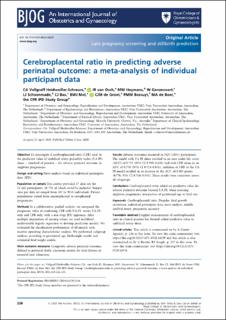| dc.contributor.author | Vollgraff Heidweiller-Schreurs, Heidweiller-Schreurs | |
| dc.contributor.author | van Osch, Osch | |
| dc.contributor.author | Heymans, Martijn W. | |
| dc.contributor.author | Ganzevoort, Wessel | |
| dc.contributor.author | Schoonmade, L.J. | |
| dc.contributor.author | Bax, C.J. | |
| dc.contributor.author | Mol, Ben W. | |
| dc.contributor.author | de Groot, Christianne J.M. | |
| dc.contributor.author | Bossuyt, Patrick M.M. | |
| dc.contributor.author | de Boer, Boer | |
| dc.contributor.author | Khalil, Asma | |
| dc.contributor.author | Thilaganathan, Basky | |
| dc.contributor.author | Turan, Ozhan M | |
| dc.contributor.author | Crimmins, Sarah | |
| dc.contributor.author | Harman, Chris | |
| dc.contributor.author | Shannon, Alisson M | |
| dc.contributor.author | Kumar, Sailesh | |
| dc.contributor.author | Dicker, Patrick | |
| dc.contributor.author | Malone, Fergal | |
| dc.contributor.author | Tully, Elizabeth C | |
| dc.contributor.author | Unterscheider, Julia | |
| dc.contributor.author | Crippa, Isabella | |
| dc.contributor.author | Ghidini, Alessandro | |
| dc.contributor.author | Roncaglia, Nadia | |
| dc.contributor.author | Vergani, Patrizia | |
| dc.contributor.author | Bhide, Amar | |
| dc.contributor.author | D'Antonio, Francesco | |
| dc.contributor.author | Pilu, Gianluigi | |
| dc.contributor.author | Galindo, Alberto | |
| dc.contributor.author | Herraiz, Ignacio | |
| dc.contributor.author | Vázquez-Sarandeses, Alicia | |
| dc.contributor.author | Ebbing, Cathrine | |
| dc.contributor.author | Johnsen, Synnøve Lian | |
| dc.contributor.author | Karlsen, Henriette Odland | |
| dc.date.accessioned | 2022-04-19T10:40:52Z | |
| dc.date.available | 2022-04-19T10:40:52Z | |
| dc.date.created | 2022-02-03T13:27:51Z | |
| dc.date.issued | 2021 | |
| dc.identifier.issn | 1470-0328 | |
| dc.identifier.uri | https://hdl.handle.net/11250/2991283 | |
| dc.description.abstract | Objective
To investigate if cerebroplacental ratio (CPR) adds to the predictive value of umbilical artery pulsatility index (UA PI) alone – standard of practice – for adverse perinatal outcome in singleton pregnancies.
Design and setting
Meta-analysis based on individual participant data (IPD).
Population or sample
Ten centres provided 17 data sets for 21 661 participants, 18 731 of which could be included. Sample sizes per data set ranged from 207 to 9215 individuals. Patient populations varied from uncomplicated to complicated pregnancies.
Methods
In a collaborative, pooled analysis, we compared the prognostic value of combining CPR with UA PI, versus UA PI only and CPR only, with a one-stage IPD approach. After multiple imputation of missing values, we used multilevel multivariable logistic regression to develop prediction models. We evaluated the classification performance of all models with receiver operating characteristics analysis. We performed subgroup analyses according to gestational age, birthweight centile and estimated fetal weight centile.
Main outcome measures
Composite adverse perinatal outcome, defined as perinatal death, caesarean section for fetal distress or neonatal unit admission.
Results
Adverse outcomes occurred in 3423 (18%) participants. The model with UA PI alone resulted in an area under the curve (AUC) of 0.775 (95% CI 0.709–0.828) and with CPR alone in an AUC of 0.778 (95% CI 0.715–0.831). Addition of CPR to the UA PI model resulted in an increase in the AUC of 0.003 points (0.778, 95% CI 0.714–0.831). These results were consistent across all subgroups.
Conclusions
Cerebroplacental ratio added no predictive value for adverse perinatal outcome beyond UA PI, when assessing singleton pregnancies, irrespective of gestational age or fetal size. | en_US |
| dc.language.iso | eng | en_US |
| dc.publisher | Wiley | en_US |
| dc.rights | Navngivelse 4.0 Internasjonal | * |
| dc.rights.uri | http://creativecommons.org/licenses/by/4.0/deed.no | * |
| dc.title | Cerebroplacental ratio in predicting adverse perinatal outcome: a meta-analysis of individual participant data | en_US |
| dc.type | Journal article | en_US |
| dc.type | Peer reviewed | en_US |
| dc.description.version | publishedVersion | en_US |
| dc.rights.holder | Copyright 2020 The Author(s) | en_US |
| cristin.ispublished | true | |
| cristin.fulltext | original | |
| cristin.qualitycode | 2 | |
| dc.identifier.doi | 10.1111/1471-0528.16287 | |
| dc.identifier.cristin | 1997406 | |
| dc.source.journal | BJOG: An International Journal of Obstetrics and Gynaecology | en_US |
| dc.source.pagenumber | 226-235 | en_US |
| dc.identifier.citation | BJOG: An International Journal of Obstetrics and Gynaecology. 2021, 128 (2), 226-235. | en_US |
| dc.source.volume | 128 | en_US |
| dc.source.issue | 2 | en_US |

